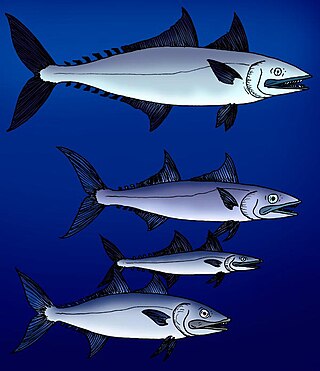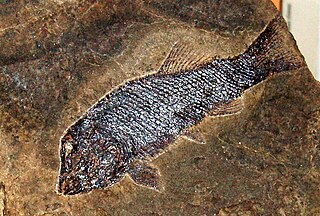Chanopsis is an extinct genus of prehistoric freshwater bonytongue relative that lived from the late Aptian to the Albian stage of the Early Cretaceous epoch. It contains a single species, C. lombardi from the Democratic Republic of the Congo.
Bobbichthys is an extinct genus of marine ray-finned fish that lived in what is now Chile during the Oxfordian stage of the Late Jurassic epoch. It was a member of the Varasichthyidae, a family of potentially crossognathiform fish.
Chongichthys is an extinct genus of prehistoric marine ray-finned fish that lived during the Oxfordian stage of the Late Jurassic epoch. It contains one species, C. dentatus from the Quebrada El Profeta of Chile. It is named after Chilean geologist Guillermo Chong.

Atopocephala is an extinct genus of prehistoric freshwater ray-finned fish that lived during the Middle Triassic epoch. It contains a single species, A. watsoni from the Karoo Supergroup of South Africa. A potential indeterminate species was known from the Timezgadiouine Formation of Morocco, but is now considered an indeterminate actinopterygian.
Broughia is an extinct genus of marine holostean ray-finned fish that lived during the Induan age of the Early Triassic epoch in what is now Greenland. Fossils were found in the Wordie Creek Formation. A potential concurrent record is also known from Madagascar.
Arctosomus is an extinct genus of prehistoric freshwater bony fish that lived during the Early Triassic epoch of Krasnoyarsk Krai, Russia. It contains a single species, A. sibiricus.

Brookvalia is an extinct genus of prehistoric freshwater ray-finned fish that lived during the Middle Triassic epoch.

Dictyopyge is an extinct genus of prehistoric freshwater ray-finned fish that inhabited eastern North America during the early part of the Late Triassic. Two species are recognized, both from the the early Carnian-aged Doswell Formation in what is now Virginia, United States:
Xyne is an extinct genus of prehistoric herring that lived during the Upper Miocene subepoch. Fossils are known from the Dicalite Quarry and Diatom Hill in California.

Thyrsocles is an extinct genus of prehistoric bony fish that lived during the Upper Miocene subepoch.

Chalcidichthys is an extinct genus of prehistoric manefish. It contains a single species, C. malacapterygius, that lived during the Upper Miocene of Southern California. It is known from the Modelo Formation in Los Angeles County, and specimens were found during construction of a tunnel on Sepulveda Boulevard. It is assumed to have preyed on siphonophores, like its living relatives.
Agecephalichthys is an extinct genus of prehistoric freshwater "palaeonisciform" ray-finned fish that lived during the Anisian age. It contains a single species, A. granulatus from the Hawkesbury Sandstone in what is now New South Wales, Australia.
Brachypareion is an extinct genus of prehistoric marine ray-finned fish that lived during the Pennsylvanian epoch. It contains a single species, B. insperatum, known from the Saur Mountains of Kazakhstan. It is placed in the paraphyletic group Palaeonisciformes.

Ainia is an extinct genus of prehistoric ray-finned fish that lived during the Kimmeridgian stage of the Late Jurassic epoch. It contains a single species, A. armata, known from the famous Solnhofen Limestone of Germany. It is a distant relative of the bowfin, although it is more closely related to genera such as Caturus and Osteorachis.

Besania is an extinct genus of prehistoric marine ray-finned fish that lived during the Anisian and Ladinian ages of the Middle Triassic epoch in what is now southern/southeastern Switzerland and northern Italy. Fossils were recovered from the Besano Formation of Monte San Giorgio area and the Prosanto Formation of canton Graubünden, Switzerland.

Aetheodontus is an extinct genus of prehistoric marine bony fish that lived during the early Ladinian stage of the Middle Triassic epoch of what is now Italy and Switzerland. It contains a single species, A. besanensis.
Cephaloxenus is an extinct genus of prehistoric marine ray-finned fish that lived during the early Ladinian stage of the Middle Triassic epoch.
Haplolepis is an extinct genus of prehistoric ray-finned fish that lived during the late Moscovian Stage of the Pennsylvanian Period. Well-preserved specimens are known from the Lagerstätte in the Upper Freeport Coal at Linton, Ohio, and were first described by John Strong Newberry in the 1800s.
Shoshonia is a Devonian-era extinct genus of prehistoric sarcopterygians, or lobe-finned fish. It contains one species, Shoshonia arctopteryx. The fish was named in reference to the Shoshoni people and the Shoshone National Forest in Wyoming, in the United States.
Eurynotoides is an extinct genus of prehistoric bony fish in the family Eurynotoididae of the order Eurynotoidiformes.









